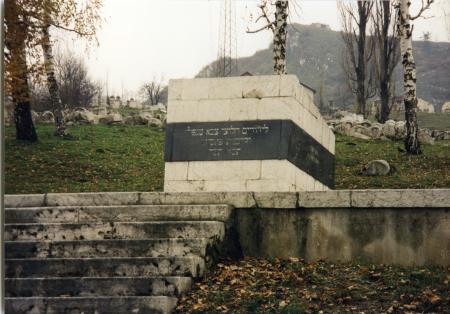Obj. ID: 33134
Jewish Funerary Art Holocaust memorial in the Old Sephardi cemetery in Sarajevo, Bosnia
To the main object: Old Sephardi cemetery in Sarajevo, Bosnia and Herzegovina

Who is Commemorated?
Jewish fallen fighters and victims of Fascism of Bosnia-Hercegovina
Description
The monument in Sarajevo was built with stone blocks that resembled those of the Western Wall in Jerusalem.
The monument was inscribed with names of and places of execution in Yugoslavia.
Inscriptions
The inscription lists death camps (Auschwitz, Bergen Belsen) and execution sites in NDH (Jasenovac, Stara Gradiška, Đakovo, Jadovno, Loborgrad).
The inscription in Serbo-Croatian cites from Gorski vijenac by Petar Petrović Njegoš and reads:
Translation: Die in glory if you have to die!
In Serbo-Croatian:
Translation: To Jewish fallen fighters and victims of Fascism of Bosnia and Hercegovina, 1941- 1945
In Hebrew:
Translation: To Jewish fallen soldiers and victims of Fascism / 5701-5705 [=1941-1945]
Commissioned by
The Jewish Community of Sarajevo and the Federation of Jewish Communities of Yugoslavia
sub-set tree:
The inauguration of this monument was part of a larger action by the Federation of Jewish Communities of Yugoslavia to unveil central monuments to the victims in Sarajevo, Belgrade, Zagreb, Novi Sad, and Đakovo in September and October 1952.
Emil Kerenji wrote about the messages that these monuments conveyed:
The dedication ceremonies and the monuments themselves reflected the dual goals of the [Jewish] Federation—the commemoration of specifically Jewish victims of the war in the context of confirmation of the officially revered legacies of the “struggle for national liberation” (narodnooslobodilačka borba) and “brotherhood and unity” (bratstvojedinstvo). Monuments were thus meant to commemorate both the “Jewish victims of Fascism” and “Jewish fallen fighters,” in accordance with the ritual mode of commemoration of World War II that was being established in Yugoslavia at the time [...].
The monuments did, however, feature Jewish motifs that were immediately recognizable to Jews, and that invoked cultural connotations that were of an entirely different order than those provided by the discourses of “victims of Fascism” and “fallen fighters.” [...] The monuments thus simultaneously conveyed two different cultural contexts—one compatible with the reigning ideological mode of commemoration of World War II, fully and literally translatable into Hebrew, the language of the new Jewish culture; and one more elusive, and accessible only to those familiar with Jewish culture and tradition.
One important caveat regarding the monuments in Yugoslavia ... is that they were located in the Jewish cemeteries. They were thus removed from the full view of the general Yugoslav public. They were located at the periphery. Monuments to general, unnamed “victims of Fascism” and “fallen fighters” were being built across Yugoslavia, in central locations in cities, towns, and villages. Monuments to Jewish victims, however, because they commemorated a specific ethnic group, could not vie for those locations. But since their primary importance for the Jewish communities in Yugoslavia lay in their potential to rally the remaining Jews in the country around a new basis for Jewish identification, their placement at Jewish cemeteries was not a drawback; on the contrary, ritual commemorations that developed over the years around these monuments only confirmed their Jewish character.
The dedication ceremonies, however, contrary to the later annual commemorations, were very visible to the general Yugoslav public. They were widely covered by the press across Yugoslavia. The numerous articles stressed: [...] Jews finally felt free and equal in the new Yugoslavia, in which the national question was solved; numerous international Jewish delegations in attendance testified to this fact, as did the presence of state representatives and the general public at the ceremonies.
[Kerenji, 2008, pp. 211-216]
The monument was damaged by Serbian shelling of the city during the siege (1992-1995), as the Jewish cemetery was on the front line.
Kerenji, Emil, “Jewish Citizens of Socialist Yugoslavia: Politics of Jewish Identity in a Socialist State, 1944–1974,” Ph.D. diss., University of Michigan, 2008, 201-222., https://deepblue.lib.umich.edu/bitstream/handle/2027.42/60848/ekerenji_1.pdf?sequence=1. June 2020 (accessed February 23, 2022)



